


|
Hose,
stockings, netherstockings, upperstockings and gamasshes: What is in
a name?
From the beginning of Queen Elizabeth's
reign, the term hose was generally used for women's stockings.
Queen Elizabeth's Wardrobe
Unlock'd (p.207) quotes that: only
gradually, by the 1600's, did hose get used to describe men's
stockings. Men's stockings were often referred to as
netherstocks.
Women's stockings, or hose were generally to
the knee or just above the knee and were footed, as seen in
Queen Elizabeth's Wardrobe Unlock'd
and A History of Hand Knitting and Textiles and
Clothing. They were made of cloth
cut on the bias to give stretch, to make them fitted and usually to
show off the man's leg! This is mentioned in both Queen Elizabeth's Wardrobe Unlock'd and A History of Hand
Knitting and Textiles and Clothing.
Netherstocks were the stocking, usually
longer than knee length, worn by men. They were pulled up over the
end of the trunkhose, sometimes tired to the trunks and secured by a
garter.
In Queen
Elizabeth's Wardrobe Unlock'd, gamasshes, or upperstockings, is conjectured to be
the name given to footless tights that came into fashion in the late
1590's. These were mostly made of silk (not known if knitted or bias
cut cloth) with a pile, possibly to keep the legs warm in winter. (p
210)
In most of my references, there is mention
of the stockings being secured by garters to stop them
falling.
A Little
History on Men's Changing 'Hose'.
In pre-Elizabethan/ Renaissance times, men's
longer hose tied to doublet as seen in Pattern of Fashion
(p16). A History of
Costume shows hose had feet (p200)
and fastened either by belt or cord and connected to doublet by
'points'. Initially men's hose had separate legs. Later the crotch
was joined and they became widened at seat for non-elastic material,
for movement, as seen in History of
Costume and Dress in Italian Painting. And, of course, there was the obligatory codpiece.
But that is another story....
In this article, I am concentrating on
women's Renaissance stockings. If you wish to make men's earlier
hose, then try the Braies and Hose
website. This gives basic
instructions on making them. A
History of Costume gives diagrams on
making joined hose and how to make measurements and adjustments, for
the more experienced costumer.
There are many pictures of earlier men's
hose in Dress in Italian
Painting including paintings of
soldiers with their hose pulled down which shows construction,
linings and how they are tied.
History of
Renaissance / Elizabethan Women's Stockings
Unfortunately there are very few extant
Italian renaissance women's stockings. I could find very little
reference to them. Hence, the article is based on Elizabethan
stockings. So this section is more correctly named: A History of
Queen Elizabeth's Stockings.
Until 1577, Henry Herne was Queen Elizabeth
I's hosier; Queen Elizabeth's
Wardrobe Unlock'd states that he
made mainly cloth stockings. After this time, there is no mention of
him as the Queen's hosier. After this date, her tailor William Jones,
was reported in the warrants in Queen
Elizabeth's Wardrobe Unlock'd, to
have made linen hose, some with Hollande clothe.
This task was then taken over by Robert Morland in 1597 who made
'several paires of doble
linen' hose.(206-7).
Ralph Abnett supplied knitted stockings from
1590-1597. (p.206-7). Robert Morland was also mentioned, in the
Michaelmas warrant 1600, in Queen
Elizabeth's Wardrobe Unlock'd, as
having supplied gamasshes and silk hoses. (p.210)
A bit about
Knitted Stockings.
So the story goes, the first knitted
stockings were given to Queen Elizabeth I, by her silkwoman Mistress
Alice Montague, in 1560 (A History of
Hand Knitting) or 1561
(Queen Elizabeth's Wardrobe
Unlock'd p.208). However, according
to A History of Hand
Knitting, this was reported in a
document published some 50 years later. In 1562, Eleanor of Toledo
was buried in her famous crimson? knitted silk stockings. So from
this we know they were in Italy at this time.
It is reported in Queen Elizabeth's Wardrobe Unlock'd that, in 1589, a stocking frame machine for knitting
rough woollen stockings was invented by Rev William Lee. Apparently
Elizabeth I did not grant a warrant nor a patent, citing that it
would cause unemployment amongst her people.
The Summe of
it's Partes - Nomenclature
|
Tops/Welts: top part of the stocking. Can be lined.
Can be embroidered. According to Queen Elizabeth's Wardrobe
Unlock'd, in the case of
knitted stocking, this was often material, eg. velvet, to
give strength
"blew gold baudeken welted with
blue vellat",
"russet wroughte vallet, the
grounde gold with a welte of orange colour
taffetta"
legs: long part of the stocking covering the shin
and calf
foot: part of stocking covering the foot
clockes: inner and outer per stocking, at the
ankle
heel: back part of stocking that covers heel of
foot.
ankle: self explanatory really
toe: ditto.
|
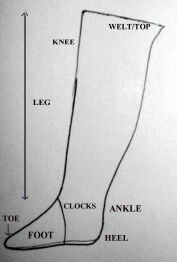
Figure 1.
|
What are
they made of?
In the case of Queen Elizabeth I, as
mentioned in Queen Elizabeth's
Wardrobe Unlock'd, stockings were
originally made from linen, silk, wool, sarcenet, flannel. Though
Elizabeth I had strict sumptuary laws regarding importing of
materials, there is also mention of imported spanish silk to make her
stockings.
Queen Elizabeth's Wardrobe
Unlock'd even mentions hose of
cotton and faustian made for Queen Elizabeth's fool, Jack.
(p.206)
There is also mention of linings and
'doble linen'. It is conjectured,
in
Queen Elizabeth's Wardrobe Unlock'd,
that this may have meant linen stockings lined with linen, or
alternatively, this could mean how the linen was woven. Other linings
mentioned were sarcenet, camerick (Textiles and Clothing) and kersey (Queen
Elizabeth's Wardrobe Unlock'd p.
207). The tops were often lined with taffetta; it is supposed that
the whole stocking may have been lined?
Dress in Italian Painting shows a lining only halfway down on the longer mens
hose (p. 26) in Piero della Francesca's 'Carryring of the sacred wood".
Textiles and Clothing states that the preferred material, from extant
stockings found, in the 16th century was worsted four-shed twill
(p.187)
Making them
pretty - What colours and decorations were used?
'Sondry colours' is a description often
used, in Queen Elizabeth's Wardrobe
Unlock'd, when quoting warrants and
descriptions from Queen Elizabeth's Warrant of Robes. Colours
mentioned for the stockings themselves include: carnation,
ashecolour, yellow, red, blew, tawny, orange, grene, strawe, white,
carnation, russet, black, crimson, including the really interesting
Elizabethan colours like Dying Spaniard and Resusicitated Corpse, a
favourite of mine. (A History of Hand
Knitting, p.70). A History of Hand Knitting also makes mention of a 1607 Dyers manual listing at
least 50 different shades available.
Trimmings mentioned in Queen Elizabeth's Wardrobe Unlock'd, in Warrant of the Robes, included: welted (tops)
with vellat, tops stitched with Irish stitch, stitched toppes and
clockes, stitched with sondry silk colours, lace of silke, venice
gold and venice silver embroidery, red fringe, yellow silke worke,
red with red silke worke, red with yellow silke worke, grene with
sondry colours....
|
Many of the descriptions in the
Warrant of Robes are not very detailed as to decoration.
Possibly some of the most detailed ones, in Queen Elizabeth's Wardrobe
Unlock'd, are:
1568: "eleven peire of cloth Hose doble welted with
vellat and lyned with sarconett stitched with
silk."
and
"of silk of sondry collors with setting on red sarcenet
lyned with red kersey" The
usual type of description was: "grene clothe trimmed with lace of silke,"
or "silke hose of diverse colours the clockes
richelie wrought with gold and silver silk."
Unfortunately there is not much
description of the actual patterns of the silke work or
embroidery.
Right: Fig 2. Queen Elizabeth's Wardrobe Unlock'd.
A picture of extant
stockings, possibly silk, with embroidered tops and silk
knitting stockings. This gives you an idea of the types of
styles used.
...And those hose for Queen
Elizabeth's Fool, made with cotton and faustian? They were
'trimmed with lace
alover'. (Queen Elizabeth's Wardrobe
Unlock'd p.206)
|
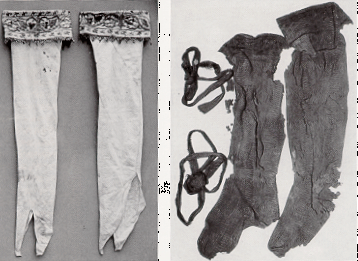
|
How were they
made in period? - A look at extant examples.
Bias cut for form and fit: There are
examples of extant stockings and hose, in Queen Elizabeth's Wardrobe Unlock'd (above) and Textiles
and Clothing. Textiles and Clothing (p. 186) give evidence of bias cut stockings and hose
in 14th century extant finds. There is some evidence of diagonally
striped leggings (men's) in Illuminations from 11th and 12th
centuries suggesting bias cut hose was present even then. The same
book also gives evidence of bias cut hose in the 16th and 17th
centuries (p.156).
Henry Herne supplied hose of cloth, flannel,
linen and sarcenet cut on the bias with seams at the back.
(Queen Elizabeth's Wardrobe
Unlock'd, p.207)
Stitching: Linen thread was usually used.
(Textiles and Clothing
p.153) Types of stitching found on
extant samples are: running stitch or back stitch used on the back
seam (p.187) for 14th century, and 16th century. Seams were flattened
and topstitched 2 -3 mm from the seam (p.156). Back seams have also
found to be overlapped 4 - 7 mm, with stitches 3 mm long, at 3-4 mm
intervals, with an upright stitch along both edges (p.155)
On makinge my
Stockings.
|
On the internet, I found several
sites showing ways of making renaissance stockings. I based
my pattern on the London hose found on Marco Carson's web
site: Some Clothing of the
Middle Ages, where he shows
patterns based on extant findings from the Barnyard's Castle
Dock. (Right: Fig 3.)
It is important that you cut the
leg and foot of the stocking on the bias, to give it
stretch, making it more fitting. The sole of the stocking is
best cut on the straight grain, so it does not distort in
shape.
There are several methods to make
the basic pattern which needs to be made for each
individual, to give the best fitting. Some involve many
measurements, as on Medieval
Womanse hose web
site, and in History of Costume. Others involved measuring and wrapping the
leg. I used calico for my basic pattern and chose the
quicker method of wrapping the calico around my leg so the
bias ran down the front of my calf. For this you need a
helper to pin the material at the back of the leg and over
the foot.. One thing you must remember, is to make sure the
ankle area is large enough to fit your foot through. I
suggest measuring around the heel over the top of your foot
and making the ankle area close to this (there is some
stretch remember). Fig. 4.
You will need to do a right foot
and a left foot, as most people have one a different size to
the other.
The length of my stockings is just
over the knee, so I can fold over the top to cover a garter
and to put my embroidery on.
|
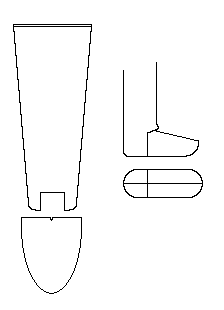
|
Materials: silk, wool, linen, veldt are
documented as being used.
For my first pair, I used a linen-cotton
blend. It was cheaper than linen for a 'first draft' pair.
Unfortunately I cannot wear wool, though I am toying with trying to
line it with linen but it is a lot of work if it will not work. I
would love to be able to afford silke cloth stockings! So I think I
will be restricted to linen.
When you have cut out your stockings, from
the final material, first finish sew across the foot of the
stockings, attaching them to the curved front of the leg (Fig 4).
Don't forget to finish the edges so they won't fray. This item is
likely to be worn and washed often. You don't want it unravelling
after your efforts. Then push the seams flat and topstitch over it.
This makes the seam flat and also is a decorative element.
Next, sew the back seam, finish edges,
flatten seams and topstitch as well (Fig 5). Finally, sew on the foot
making sure the centre back heel and front match. (Fig 6).
Personally, I like the look of an
embroidered top which folds down over the garter. I have embroidered
a guard to use this for the top and lined or 'doble welt'. Fig 7
shows my stockings without the embroidered guards. Fig 8. is an
enlargement of the finished welts/tops of the stockings- I used split
stitch, stem stitch and chain stitch. The design was based on designs
in Queen Elizabeth
Unlock'd, using pomegranites and
leaves and my SCA device. Fig 9. is the finished articles!!!
Finally!!
|
Fig 8 The embroidery for the tops/welts
of my stockings.
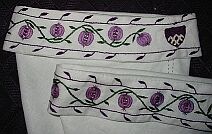 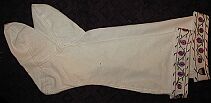
R: Fig
9 The finished
product !!
|
Here is some more stockings I have made
recently for Festival, Lochac's biggest camping event: Red linen
renaissance stockings.
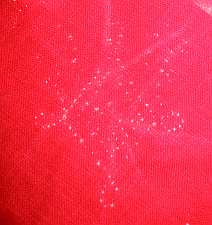 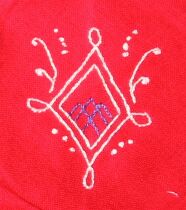 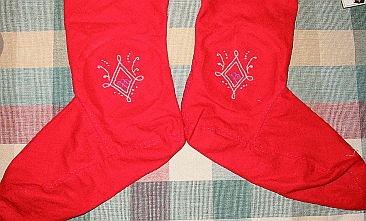
Fig 1. Pattern for embroidery pricked for transfer, based on portrait
of Mary Curzon by William Larkin 1610
Fig 2. Split stitch embroidery
Fig 3. Finished stockings - ready for Festival!
Troubleshooting
- If the seam is uncomfortable to stand
on, you will need to ensure it has been flattened and
topstitched.
- If the centre back seam is not central,
then the hose will tend to twist.
- If you forget to use separate right and
left patterns, one stocking may be too tight. Usually, it is the
right foot and leg bigger than the left.
- If you lose circulation due to a tight
garter, please also remember it is best to tie your garter just
under the knee, so it sits above the larger part of the
calf.
How to holde yer stockings upon
yer legges.
The Renaissance equivalent of the 'elastic
to hold up your socks' is the garter to hold up your stockings.
"hose over the knee secured with
garters" (Queen Elizabeth's Wardrobe
Unlock'd)
Textiles and Clothing mentions garters being narrow 75-100 mm width lengths
woven from worsted yarn, often in four-shed, broken chevron or twill
fashion. (p.142). These lengths were often cut into matching garters.
Narrow garters of 18-32 mm widths were found in 14th century finds.
One of the most detailed entries in Queen Elizabeth's Wardrobe Unlock'd for the Warrant of Robes was from 1595 and not
unfortunately about stockings but the garters!:
"to Roger Montague ....for cutting in
peces and setting together with heringe bone stitche one payre of
carnation ingrayne silk garters, the ends with silver lace, hemmed
round with perfoumed with vj payre of pendaunte buttons of silver
twisted with carnation ingrayne silk" (p. 224)
Another description of some of Queen
Elizabeth's garters was from 1594 Michaelmas warrant for John
Parr:
"garters of ashecolour silke sipers
richilie wrought with lyllies and hollies of gold and silver
silke."
|
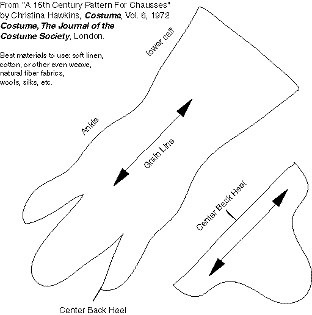
|
Alternative Patterns for
Clothe Stockings
Here is alternative pattern similar
to the hose from Queen Elizabeth's Wardrobe Unlock'd (Fig
2). Fig. 8 is from the Renaissance Tailor's website.
|
On making Knitted
Stockings
There are those of you are much more adept
at knitting than I. For details on knitted hose try the
Hand Knit Hose website by Donna Flood Kenton. This gives details on
how to make a pair of knitted hose.
Glossary:
Camerick - fine white linen originally made at Cambray in
Flanders
Chevron - for of twill weave with diagonal lines reversed
(gives 'V' pattern)
Crewell- think worsted lyarn of 2 threads used for
embroidery and knitting.
Clockes - area of stocking covering the ankle bone, inside
and outside on each leg. Could be
decorated and embroidered, either on inside and outside or just the
outside of the leg.
Extant - actual surviving
items originally made at the time in question
Guards - oranamental band of decoration on a garment.
Originally used for reinforcement to keep the edges of a garment
fraying (as on hems)
Jersey - type of thread - wool or cotton or silk? (depending
on the source used) used for knitting or type of knitting.
Kersey - thin wool of narrow width possibly originally made
in Keysey, Suffolk.
Points - cords, ribbons, braids, laces or leather used for
tying on sleeves, hose, attatching doublets to trunk hose etc.
usually has ends covered in metal aglets (cones).
Sarcenet - thin silk taffetta often used for lining.
Shed
- opening in warp (long threads arranged on loom) that allows passage
of weft (threads passed trough the 'sheds') threads.
Twill- weave type, giving diagonal lines in material.
Vellat- velvet; warp pile weave, with raised loops
Venice gold - silver gilt thread imported from Venice
Venice silver - silver thread imported from Venice
Worsted - a smooth thread spun from wool fibres, laid parallel
by combing.
Appendix: Concerning Sumptuary
Laws on Hose
From Elizabethan Sumptuary Laws
website.
[Westminster, 6 May 1562, 4 Elizabeth
I]
Printed by R. Jugge and J. Cawood (London,
1562): Articles for the execution of the Statutes of Apparel, and for
the reformation of the outrageous excess thereof grown of late time
within the realm, devised upon the Queen's Majesty's commandment, by
advice of her Council, 6 May 1562
.........
that no tailor, hosier, or other person, whosoever he shall be,
after the day of the publication hereof, shall put any more cloth
in any one pair of hose for the outside than one yard and a half,
or at the most one yard and three-quarters of a yard of kersey or
of any kind of cloth, leather, or any other kind of stuff above
the quantity; and in the same hose to be put only one kind of
lining besides linen cloth next to the leg if any shall be so
disposed; the said lining not to lie loose or bolstered, but to
lie just unto their legs, as in some ancient time was accustomed;
sarcanet, muckender, or any other like thing used to be worn, and
to be plucked out for the furniture of the hose, not to be taken
in the name of the said lining. Neither any man under the degree
of a baron to wear within his hose any velvet, satin, or other
stuff above the estimation or sarcanet or taffeta.
........ all hosiers or tailors making
hose dwelling within the precincts of the same, and shall bind
every of them in the sum of £40 or more as cause shall
require, to the Queen's Highness's use, to observe this part of
this said proclamation touching hose, without any manner fraud or
guile
...... If any hosier shall refuse to
enter into such bond, to be immediately committed to ward and to
be suffered no more to continue his occupation.
Bibliography:
Books:
1. Arnold, Janet Queen Elizabeth's Wardrobe Unlock'd, Maney, Leeds, 1988, ISBN:0-901286-20-6
2. Arnold, Janet
Patterns of Fahsion, MacMillan,
London, 1985. ISBN: 0-333-38284-6
3. Birbari, Elizabeth Dress in
Italian Painting 1460-1500 W&J
Mackay Lit, Hatham, 1975
4. Crowfoot E, Pritchard F & Staniland K, Textiles and Clothing 1150-1450, Boydell Press, Woodridge, 2001 (ed) ISBN:
0-85115-840-4
4. Holmes & Meier, NY. Rutt, Richard. A History of Hand Knitting. Interweave Press, 1987.
5.Kohler, Carl A History of Costume,
Coles Inc, NY. 1980
6. The Macquarie
Dictionary 2nd Revised Ed. Macquarie
Library, 1989. ISBN: 0-949757-41-1
Websites:
1. Caerleon, Megge,Medieval Women's Hose: www.antir.com/meghan/hose.html (revisited:
22/7/03)
2. Caerleon, Megge, Tempus
Peregrinator's Sewing & Garb Accessories Site: Bag
Stockings
http://www.pipcom.com/~tempus/sewing/legs_bsocks.html (revisited:
22/7/03)
3. Carlson, Marc Some Clothing of the
Middle Ages.
www.personal.utulsa.edu/~marc-carlson/cloth/hose.html (24/5/03
4. Chausses and
Braies:
www.randyasplund.com/browse/medieval/chausse1.html (3/11/02)
5. From Elizabethan Sumptuary
Statutes website.
http://renaissance.dm.net/sumptuary/ (revisited 28/7/03)
6. Historical Shoe designs: Footed hose (14th -16th C):
www.bm.com/~lindahl/carlson/SHOES/SHOES54.HTM (31/3/98)
7. Kenton, Donna Flood. Hand Knit
Hose. 1998:
www.dabbler.com/ndlwrk/stocking.html (5/8/00, revisited 22/7/03)
8. McGann, Kass, The Carnamoyle
Stockings #8212; Irish Wool Stockings from the 16th
Century
http://www.reconstructinghistory.com/irish/stocai.html (24/5/03)
9. Renaissance Tailor: Demonstrations: Stockings:
http://www.vertetsable.com/demos_stockings.htm (revisited
23/7/03)
More about Lady Katerina da Brescia.
OoL, AOA, ost, oroli, ofg, ogo, okn.
Katerina lives in the Barony of Innilgard.
She used to be a Privateer, made her fortune, met a handsome, younger
man, retired and got married. She now lives the life of a noble, in
Fiorenze, and does not have enough time for all of her interests
(especially while looking after her two year old child): garb making,
calligraphy and illumination, drawing, researching, bobbin lace,
glove making, archery.... always finding something else of interest
to do (now embroidery and silverpoint)... She is head of the
household Casa Viola, is protégé to Mistress Aislinn de
Valence, and is currently serving as the Kingdom Arts and Science
Minister of Lochac. Katerina has served as Baronial Rapier Marshal in
years passed (now retired due to injury), and served as a Baronial
and Canton A&S Officer. She is a member of the College of Scribes
(Journeyman), the Painters and Limners Guild of Lochac(Verger and
Chronicler) and recently joined the Worshipful Company of Broiderers
(Apprentice).
|

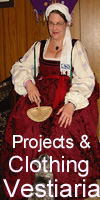

|